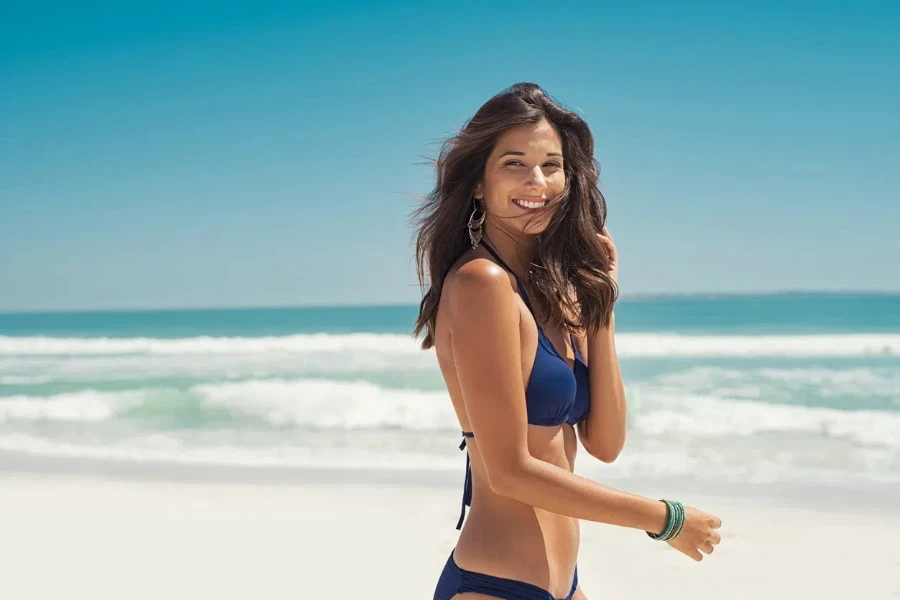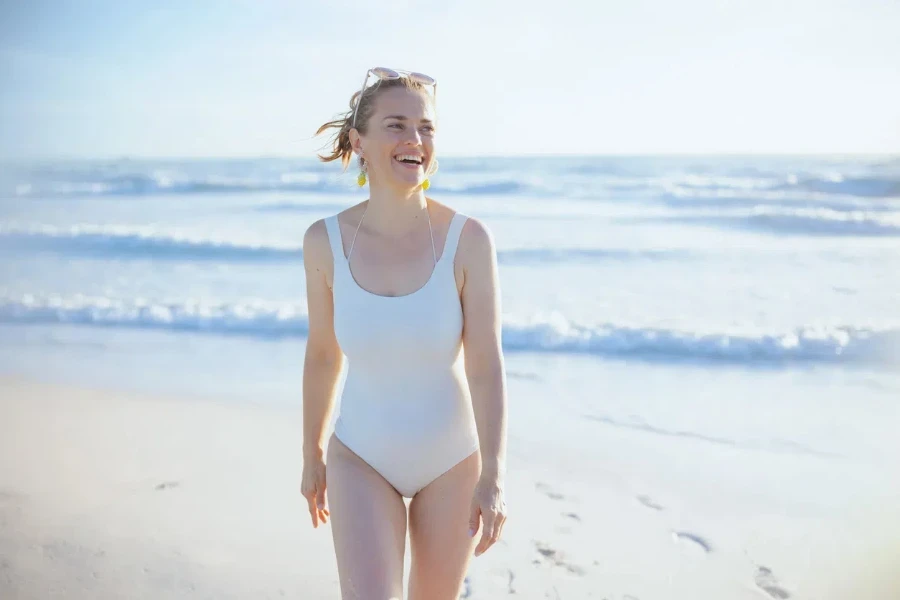The global market for bikinis and beachwear is experiencing a significant surge, driven by evolving fashion trends, increasing disposable incomes, and a growing inclination towards beach vacations and water sports. This article delves into the current market landscape, highlighting key regions, consumer demographics, and preferences that are shaping the future of this vibrant industry.
Table of Contents:
– Market Overview: The Global Demand for Bikinis and Beachwear
– Trendy Designs and Styles Making Waves
– Technological Innovations in Swimwear
– Influences Shaping the Market
– Sourcing and Supply Chain Insights
Market Overview: The Global Demand for Bikinis and Beachwear

Current Market Size and Growth Projections
The global market for swimwear and beachwear is estimated at USD 27.5 billion in 2023 and is projected to reach USD 41.1 billion by 2030, growing at a compound annual growth rate (CAGR) of 5.9% from 2023 to 2030, according to Research and Markets. This growth is fueled by a combination of factors, including the rising popularity of beach vacations, increased participation in water sports, and the influence of social media on fashion trends.
The polyester swimwear and beachwear segment is expected to reach USD 15.5 billion by 2030, with a CAGR of 6.8%. Similarly, the spandex segment is set to grow at a CAGR of 5.9% over the same period. These projections highlight the robust demand for durable and flexible swimwear materials that cater to diverse consumer needs.
Key Regions Driving Demand
The United States and China are key regions driving the demand for bikinis and beachwear. The U.S. market is estimated at USD 7.3 billion in 2023, while China is forecasted to grow at an impressive CAGR of 8.8%, reaching USD 9.3 billion by 2030, as reported by Research and Markets. Other significant markets include Japan, Canada, Germany, and the Asia-Pacific region, where rising disposable incomes and growing tourism are contributing to increased demand.
Asia-Pacific, in particular, is the largest region in the swimwear market, driven by rapid technological advancements, an evolving fashion industry, and rising expenditure capacities of consumers. The region’s market size reached USD 17.5 billion in 2023 and is expected to grow to USD 25.2 billion by 2032, exhibiting a CAGR of 4.1% during the forecast period.
Consumer Demographics and Preferences
Consumer preferences in the swimwear market are diverse and influenced by various factors, including age, gender, and lifestyle. The market is segmented into women’s, men’s, and children’s swimwear, with women’s swimwear representing the largest segment. According to Research and Markets, the growing popularity of inclusive sizing and body-positive approaches is driving demand for a wider range of swimwear options that cater to different body types and preferences.
Additionally, the increasing focus on sustainability is shaping consumer choices, with a growing demand for eco-friendly swimwear made from recycled materials. Brands are responding to this trend by launching sustainable collections and adopting environmentally friendly production practices.
Trendy Designs and Styles Making Waves

High-Waisted Bikinis: A Retro Revival
High-waisted bikinis have made a significant comeback, drawing inspiration from the vintage styles of the 1950s and 60s. This trend is not just about nostalgia; it offers practical benefits such as enhanced comfort and a flattering silhouette. The high-waisted design provides more coverage and support, making it a popular choice among a diverse range of body types. According to the Design Capsule for Women’s Festival Swimwear, the high-waisted bikini is often paired with playful elements like ruffles and broderie anglaise fabrics, which add a romantic, bohemian touch to the overall look. This style is versatile, working well as both swimwear and a beach cover-up, especially when made from sustainable materials like recycled poly/nylon or natural fibers such as GRS cotton, hemp, or linen.
Sustainable Swimwear: Eco-Friendly Choices
Sustainability is no longer a niche market but a mainstream demand. Consumers are increasingly looking for eco-friendly options, and the swimwear industry is responding with innovative materials and practices. Brands are now using recycled or bio-based fabrics, such as those made from castor beans or recycled PET, to create swimwear that is both stylish and environmentally responsible. The Design Capsule emphasizes the importance of designing for longevity, encouraging the use of modular, versatile items that can be adapted and restyled. This approach not only reduces waste but also extends the life of the garment, making it a more sustainable choice.
Bold Prints and Patterns: Making a Statement
Bold prints and patterns are making waves in the swimwear industry, offering consumers a way to express their individuality and make a statement. According to the Why Ocean Girls Will Be Everywhere in 2025 report, aquatic prints featuring coral and shell motifs are particularly popular, inspired by the Miami Swim shows. These prints are often elevated with embellishments like gold shell clasps, beads, or shells, adding a touch of luxury to the designs. The trend is not limited to swimwear; it extends to kaftans, shirts, and shorts sets, creating a cohesive beachwear collection that stands out.
Mix-and-Match: Customizable Beachwear Options
The mix-and-match trend allows consumers to create personalized beachwear looks by combining different tops and bottoms. This trend is driven by the desire for versatility and customization, enabling individuals to express their unique style. The Design Capsule for Women’s Knitwear and Jersey highlights the importance of creating vacation-ready pieces that can be mixed, matched, and styled with wardrobe staples. This modular approach not only offers more outfit options but also encourages sustainable consumption by maximizing the use of each piece.
Technological Innovations in Swimwear

Quick-Dry Fabrics: Enhancing Comfort and Convenience
Quick-dry fabrics are revolutionizing the swimwear industry by offering enhanced comfort and convenience. These fabrics are designed to wick moisture away from the body, allowing the swimwear to dry rapidly after a swim. This innovation is particularly beneficial for active beachgoers who want to transition seamlessly from water activities to other beachside pursuits. According to the Design Capsule, incorporating quick-dry fabrics into swimwear designs not only improves the user experience but also adds a functional element that appeals to modern consumers.
UV Protection: Safety Meets Style
With increasing awareness of the harmful effects of UV radiation, swimwear with built-in UV protection is becoming a must-have. These garments are designed to block out harmful UV rays, providing an extra layer of protection for the skin. The Design Capsule for Kids’ Swimwear emphasizes the use of recycled nylon with built-in sun protection, highlighting the dual benefits of sustainability and safety. This trend is particularly important for families, as it offers peace of mind while enjoying outdoor activities.
Smart Swimwear: Integrating Technology for a Better Experience
Smart swimwear is an emerging trend that integrates technology to enhance the user experience. These innovative garments can include features such as built-in sensors to monitor UV exposure, track swimming performance, or even provide real-time feedback on posture and technique. While still in the early stages of development, smart swimwear represents the future of the industry, offering a blend of fashion and functionality that caters to tech-savvy consumers.
Influences Shaping the Market

Celebrity Endorsements and Social Media Impact
Celebrity endorsements and social media have a significant impact on swimwear trends. Influencers and celebrities often set the tone for what is fashionable, with their choices quickly becoming popular among their followers. According to the Why Ocean Girls Will Be Everywhere in 2025 report, the personas of Beach Babe, Mermaid Glam, Ahoy Sailor, and Aquatic Splash are driving consumer preferences, with social media platforms playing a crucial role in disseminating these trends. Brands are leveraging these platforms to showcase their latest collections, engage with consumers, and build brand loyalty.
Seasonal Trends: How Weather Affects Sales
Seasonal trends and weather patterns have a direct impact on swimwear sales. The demand for swimwear typically peaks during the summer months, with consumers looking for the latest styles to wear on their beach vacations. However, the Design Capsule notes that the trend of dressing up for festivals and vacations is extending the swimwear season, as consumers seek versatile pieces that can be worn beyond the beach. This shift is creating new opportunities for brands to market their swimwear collections year-round.
Cultural Influences: Regional Preferences and Styles
Cultural influences play a significant role in shaping swimwear trends, with regional preferences and styles varying widely. For example, the Design Capsule highlights the popularity of boho and Western looks in the summer 2024 circuit, with these aesthetics being reworked for a more dressed-up, festival-ready vibe. Similarly, the Why Ocean Girls Will Be Everywhere in 2025 report notes the influence of surf themes and aquatic motifs on the Spring 2025 runway, reflecting a broader cultural fascination with the ocean and marine life. Understanding these cultural nuances is essential for brands looking to cater to diverse markets and create designs that resonate with local consumers.
Sourcing and Supply Chain Insights

Key Manufacturers and Suppliers
The swimwear industry relies on a network of key manufacturers and suppliers to produce high-quality garments. According to the Design Capsule, brands like Nau Swim and Frankies Bikinis are leading the way with their innovative designs and sustainable practices. These manufacturers are known for their attention to detail, use of high-quality materials, and commitment to sustainability, making them valuable partners for swimwear brands looking to create standout collections.
Quality Control and Certifications
Quality control and certifications are critical in ensuring that swimwear meets the highest standards of performance and safety. The Design Capsule emphasizes the importance of using certified recycled or bio-based fabrics, as well as implementing rigorous quality control measures throughout the production process. Certifications such as GRS (Global Recycled Standard) and OEKO-TEX® are essential in verifying the sustainability and safety of the materials used, providing consumers with confidence in their purchases.
Logistics and Distribution Challenges
Logistics and distribution are key challenges in the swimwear industry, particularly given the seasonal nature of the market. Ensuring timely delivery of products to retailers and consumers is crucial, especially during peak seasons. The Design Capsule notes that brands must navigate complex supply chains, manage inventory effectively, and adapt to changing consumer demands to stay competitive. Leveraging technology and data analytics can help streamline these processes, improving efficiency and reducing costs.
Conclusion
The swimwear industry is undergoing a dynamic transformation, driven by trends in design, technology, and consumer preferences. High-waisted bikinis, sustainable swimwear, bold prints, and mix-and-match options are leading the way in fashion, while technological innovations like quick-dry fabrics, UV protection, and smart swimwear are enhancing functionality. Influences from celebrities, social media, seasonal trends, and cultural preferences are shaping the market, creating new opportunities for brands to connect with consumers. As the industry continues to evolve, a focus on sustainability, quality, and innovation will be key to staying ahead of the curve. Looking to the future, the integration of technology and a commitment to eco-friendly practices will define the next generation of swimwear, offering consumers stylish, functional, and responsible choices for their beachwear needs.




